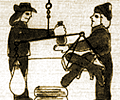|
- Enrichment/Extension:
- Have the students prepare
food of the Fur Trade era. One such example is bannock.
Bannock is the traditional bread that Native Canadians, trappers and
pioneers cooked over an open fire. The recipe follows.
- 5 cups flour
- 1 tsp. salt
- 2/3 cup shortening
- 2/3 cup milk powder
- raisins, dried fruit, nuts, or pie filling (optional)
- Combine ingredients, except pie filling, and add enough water to make
a dough. Wrap dough thinly around a stick. Roast over coals
until golden brown. Put pie filling in the hole of the stick.
Recipe makes lots! (Bannock can also be fried in a pan.)
STUDENT WORKSHEET:
Group members:
Outfitting for a Fur Trade Expedition
Your supplies are running low and you have to go trap some more animals
to get some more furs. You will be gone for two months during the
winter. On your expedition, you will probably have to trade with
some of the Natives because they are very skilled hunters and trappers.
There are many things that you are going to need for your trip. In
groups of four, make a list of what you will need. Each group member
must have a role as time keeper, note taker, encourager, or team leader.
If you are working in a group of three, the team leader can also be the
encourager. Be prepared to justify why you would need these items.
The Hudson's Bay Company's website in Canada's Digital Collections shows
several artefacts from the era of the Fur Trade. Add to your lists
at least one thing from each section (personal goods, trade goods, equipment,
currency in the fur trade). Remember the time period we are studying
(1544-1759). You would not have access to any artefacts that are
not from this time period.
Things we need:
Things the Hudson's Bay Company website reminded us that we need:
Peer
Evaluation
Name_________________________
Evaluate your teammates on their performance. The scale is
from 1 to 5. The teacher is the only one who will see your
evaluation so please be fair and honest with your responses.
1 = not acceptable 2 = poor but okay
3 = satisfactory 4 = very good
5 = excellent
| GROUP MEMBER |
| played his/her role in the team |
1 2 3 4
5 |
1 2 3 4
5 |
1 2 3 4
5 |
| contributed appropriately to the group's answers |
1 2 3 4
5 |
1 2 3 4
5 |
1 2 3 4
5 |
| worked well with other group members |
1 2 3 4
5 |
1 2 3 4
5 |
1 2 3 4
5 |
| participated in the group presentation |
1 2 3 4
5 |
1 2 3 4
5 |
1 2 3 4
5 |
| TOTAL |
|
|
|
Peer Evaluator name:_____________________
Comments:
Teacher Evaluation of
Presentations
| STUDENT: |
| quality of examples |
1 2 3 4
5 |
1 2 3 4
5 |
1 2 3 4
5 |
1 2 3 4
5 |
| quality of reasoning |
1 2 3 4
5 |
1 2 3 4
5 |
1 2 3 4
5 |
1 2 3 4
5 |
| communication of answers |
1 2 3 4
5 |
1 2 3 4
5 |
1 2 3 4
5 |
1 2 3 4
5 |
| team skills in presentation |
1 2 3 4
5 |
1 2 3 4
5 |
1 2 3 4
5 |
1 2 3 4
5 |
| TOTAL |
Comments:
- Specific Excerpts
from SchoolNet's Hudson's
Bay Company Collection:
- Possible Answers for the "Expedition Preparation"
- Background Information from the Hudson's Bay Company's
SchoolNet web site
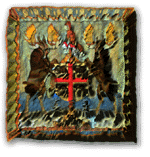
"A GIFT TO THE NATION"
THE HUDSON'S BAY COMPANY MUSEUM COLLECTION
©1996 Manitoba Museum of Man and Nature
On March 15, 1994, the Hudson's Bay Company announced the donations of
its museum collection to the Manitoba Museum of Man and Nature and its
corporate archival records to the Provincial Archives of Manitoba. In addition,
a number of artifacts relevant to the interpretation of the national historic
site of Lower Fort Garry were donated to Parks Canada. These donations
were in keeping with the Company's practice of transferring its assets
that are part of Canada's heritage to public ownership as indicated by
three previous gifts -the national historic park sites of Lower Fort Garry
and York Factory and the replica of the Nonsuch located at the Manitoba
Museum of Man and Nature.
The entire tax savings
accruing from the museum and archival gifts under the provisions of The
Movable Cultural Property Division of the Department of Canadian Heritage
will be dedicated to the Hudson's Bay History Foundation and the Hudson's
Bay Charitable Foundation. The Hudson's Bay History Foundation will be
used "to advance knowledge of, and interest in, Canadian history through
financial assistance to qualified organizations." In addition to annual
operating funds, the Foundation will provide the Manitoba Museum of Man
and Nature with 2 million dollars to house the collection in the future
Hudson's Bay Company wing. The Manitoba Archives will receive funding for
capital upgrading to house and preserve the Company's archival materials.
In addition, a newly-formed Popular History Society will receive an annual
grant.
In the words of Mr. Gary
Filmon, the Premier of Manitoba, "these gifts, along with the financial
support to care for them, represent an unprecedented act of corporate social
responsibility and generosity." Together with the replica of
the Nonsuch, the Hudson's Bay Company Museum Collection will enable the
museum to further document and interpret the history of the fur trade and
will provide unprecedented opportunities for joint research and public
education projects with the Hudson's Bay Company Archives, Parks Canada, universities
and scholarly organizations such as the Rupert's Land Research Centre,
and the Aboriginal, Metis, and Inuit communities.
Hudson's Bay Company Fur Trade Artefacts
- A. PERSONAL GEAR
- A
- HBC 57-20 A-F : CREE-METIS SMOKE TANNED CARIBOU
HIDE JACKET, LEGGINGS, and GARTERS with ASSUMPTION SASH
- HBC 39-55 A-Z : OFFICER'S CASSETTE
- HBC 1295 : CAPOTE; 1920s
B. TRADE GOODS
-
- B1
- HBC 37-64 : CURVED KNIFE; Fox Trademark; England;
early 1880s
- HBC 78-6 : AXE HEAD
- HBC 57-73 : PIPE-TOMAHAWK; G.B. Fenstermaker;
Lancaster, Pennsylvania

- HBC 73-218 A : FLINT AND STRIKE-A-LIGHT
- Flints for creating sparks for muskets, fires and pipe-smoking, and
steel strike-a-lights were common trade goods that were carried by men
in their pipe bags.
B2 TRADE GOODS
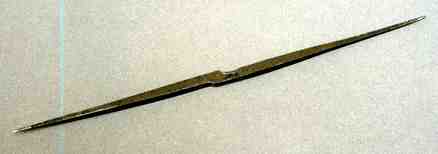
- BC 37-148: AWL
- One of the first types of metal goods traded.
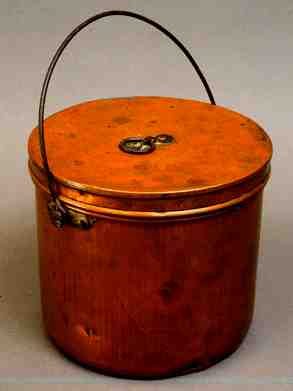
- HBC 57-46: COPPER KETTLE
- Copper kettles were introduced by the Company in the late 1700s
for Aboriginal trade; they were also used by Company men. Birmingham Sheffield
were the centres where both brass and metal kettles were manufactured.
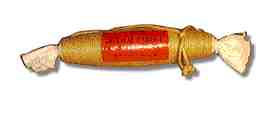
- HBC 59-67: TOBACCO CARROT; reproduction
- In the 18th C. much of the tobacco was prepared in this form. The HBC
had its private brands prepared by the Imperial Tobacco Company.
Tobacco carrots came in various weights up to 15 pounds.
B3. TRADE GOODS
HBC 60-21 A : LINEN THREAD; HBC 60-18 C,D : NEEDLES
HBC 60-14 A-E : LLAMA BRAID FOR DECORATIVE EDGING ON CLOTHING
HBC 60-22 A-C: EMBROIDERY THREAD
B4. TRADE GOODS
HBC 2783 A,J; HBC 60-24 C,D : GLASS BEADS

- HBC 58-99 G : NUMBER 3 STEEL TRAP
- For trapping beaver, badgers, raccoons, lynx or bobcats.
HBC 2327 B : BARNETT FLINTLOCK; MODEL 1871; LONDON
C. EQUIPMENT
C1
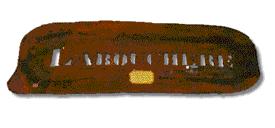
- HBC 1450 J : STENCIL
- Used to mark fur bales and merchandise from various posts.
HBC 37-141 : BEAM SCALE
HBC 1218 : DOG CARRIOLE; 1908
C2
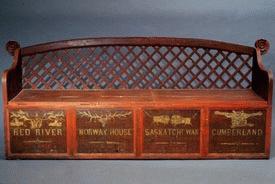
- HBC 1237 : BENCH/LETTER BOX
- This unique packet and letter box was made from a bench originally
located at Cumberland House, Saskatchewan prior to 1850. The box is divided
into four compartments representing four trading districts: grasshoppers
and crocus for Red River; a stag's head for Norway House; two bison for
Saskatchewan; and a bear for Cumberland House. Cumberland House received
the Northern District's mail in addition to the mail for Saskatchewan,
Edmonton, York Factory, Norway House, Fort Garry and European mails.
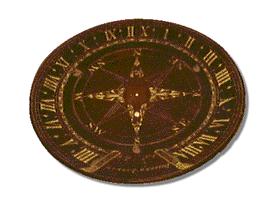
- HBC 2119 : SUN DIAL PLATE; LONDON
- Collected from York Factory.
D. CURRENCY IN THE FUR TRADE
- HBC 82 C,G,I : OAK TOKEN STICKS
- Counters branded with the number one to indicate a value of one made beaver.
They were used at Fort Churchill in the 1800s and at other Arctic posts.
- HBC 1989 A-D : EAST MAIN TOKENS
- Set of brass tokens in denominations of 1 MB (Made Beaver), 1/2 MB,
1/4MB, and 1/8 MB introduced in the late 1800s by Inspecting Chief
Factor George Simpson McTavish. Barter or "goods for goods," was the original
method used by the Hudson's Bay Company in their trade with Aboriginal peoples.
This system was replaced with the use of counters in the
forms of ivory discs, wooden sticks, bird quills, musket balls and
other objects. In the late1800s,these counters gave way to metal tokens with
values stamped on them. The unit of value in trading for furs in the
Subarctic was one Made Beaver (MB),that is, a beaver pelt in its prime condition.
HBC 60-80 I; HBC 60-87A; 60-88 E; HBC 60-89;
- HBC 60-90 B
- HBC 60-80 I; 60-88 E
- Ralph Parsons issued tokens made from recycled copper and lead
for use in northern Quebec and Baffin Island in the early 20th C. In
this trading district, the pelt of the white fox was adopted as the
standard of value for trade. The various shapes and sizes of the tokens
represented the different animal pelts
- HBC 46-39 : EASTERN ARCTIC TOKEN
- The number "one" represents the white Arctic fox as the standard of value of trade
|

